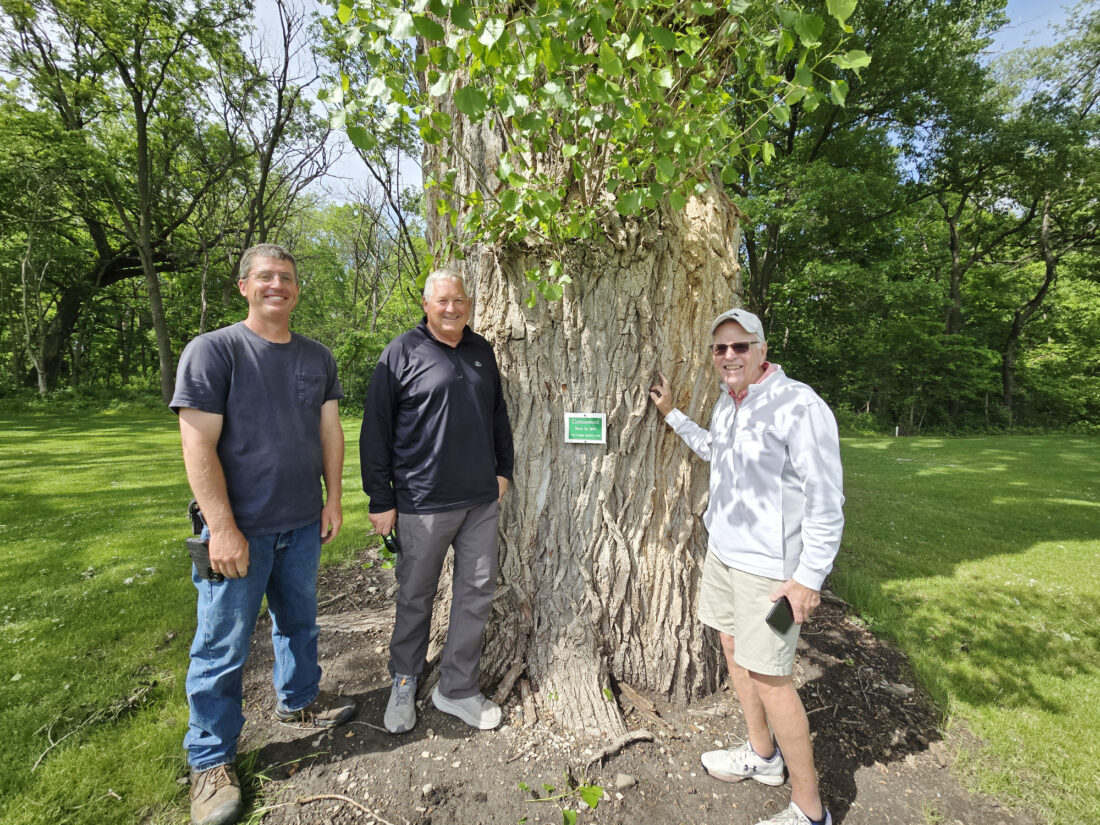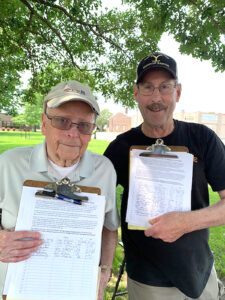‘LIVING HISTORY’
Project assigns ‘birth’ dates to Fort Dodge Country Club’s most venerable trees
-
-Messenger photo by Eric Pratt
From left, Fort Dodge Country Club Course Superintendent Mark Siems, member Roger Brown and member Dave Sergeant stand together at the base of the cottonwood tree on hole 17 Friday. The three have worked together to finish a project that identifies the ages of certain trees on the Fort Dodge Country Club course with plaques identifying the type of tree and its “birth” date. This cottonwood is from 1863.
-
-Messenger photo by Eric Pratt
Fort Dodge Country Club member Dave Sergeant points to a bur oak tree with a 1775 birth date, believed to be the oldest on the course. Sergeant spent years researching the ages of trees and has identified a number of them with “born on” plates at the Fort Dodge Country Club.

-Messenger photo by Eric Pratt
From left, Fort Dodge Country Club Course Superintendent Mark Siems, member Roger Brown and member Dave Sergeant stand together at the base of the cottonwood tree on hole 17 Friday. The three have worked together to finish a project that identifies the ages of certain trees on the Fort Dodge Country Club course with plaques identifying the type of tree and its “birth” date. This cottonwood is from 1863.
It predates the Fort Dodge Country Club, founded in 1911.
It’s older than the city of Fort Dodge, established in 1854, and even Iowa, which became a state in 1846.
This bur oak, standing tall and resolute guarding the grove of trees shared by holes 1 and 18 at the Fort Dodge Country Club, has actually been around since the days of the Declaration of Independence.
Or 1775, to be exact.
“Think of what that guy has seen,” retired Fort Dodge lawyer and golfer Dave Sergeant said standing next to it recently, marveling at its stature and age. “Just fascinating.

-Messenger photo by Eric Pratt
Fort Dodge Country Club member Dave Sergeant points to a bur oak tree with a 1775 birth date, believed to be the oldest on the course. Sergeant spent years researching the ages of trees and has identified a number of them with “born on” plates at the Fort Dodge Country Club.
“Bur oaks are the state tree, too. And I’ve read some live 400 or even 500 years.”
Sergeant was speaking like both a proud caretaker and amateur historian. For the last few golf seasons, the long-time amateur standout has taken on a side project: identifying the ages of his home course’s oldest living residents.
“I’ve learned so much about trees in general,” the 80-year-old Sergeant said. “For decades really, I’d play a round of golf and not give it much thought. I’d admire the size or the likely age of one and just go on my way, like most people do.
“I’m glad I started to think from a different perspective, because this has really been a fun and educational experience.”
Sergeant was on his annual spring golf trip to Mississippi in 2021 when he first noticed many of the older trees on the courses featured plaques with “birth dates.”
“I thought it was interesting, especially considering some trees seemed to be older than you’d assume and some were younger (despite their size),” Sergeant said. “I started asking around some about how these courses determined the age of their trees, knowing we had a lot (at the FDCC) that I figured had to be at least 150 years old.”
Sergeant had heard of the more traditional methods to determine how long a given tree had been around. Through his research, he learned of a more efficient, cost-effective process.
“Without cutting it down and counting the growth rings, I knew you could also use an (increment) borer and take a core sample (to be studied),” Sergeant said. “But I found out that process can be kind of pricey, and it potentially introduces the tree to damage or infection. So I wasn’t going to go that route.”
Sergeant was told of a formula that starts with measuring the circumference of a tree at four and a half feet tall, determining the diameter by dividing the circumference by Pi (3.14) while identifying the growth factor of the specific species.
“You then multiply the growth factor by the diameter and it gives you an accurate estimation of the age,” Sergeant said. “The people in Hancock County down in Mississippi have a registry for Southern Live Oaks, and I was able to get the information from them as far as how they determine that ‘birth’ date. They even get it registered as official with the state.”
Last summer, Sergeant began measuring and calculating at the Fort Dodge Country Club.
“I had some notes for trees and identified a few to study, so I hopped in a cart with my daughter and we started the process,” he said.
About a week and a half later, Sergeant had gathered data for 32 trees on the 18-hole course.
“The (large) cottonwoods on (holes) 4 and 17 were obvious candidates,” Sergeant said. “I also knew we had a lot of bigger bur oaks, and from my research, I found out they grow at a slower rate than cottonwoods and silver maples. Bur oaks are among the slowest growing trees around. They also last longer because of their thick bark, which makes them more resistant to natural hazards like wind or fire.
“You tend to assume the bigger the tree, the older it is. But so much has to do with not just the type, but its growth rate.”
When Sergeant and his wife, Sue, got done playing a round in a couples league last July, he mentioned the project to Fort Dodge’s Roger and Jackie Brown.
“We were talking about the cottonwood on 17 and I pointed out that the one on 4 is actually older, but neither are the oldest on the course,” Sergeant said. “Roger asked what I was talking about and how I knew. When I told him what I’d been doing, he was on board with the idea right away.”
Brown went to work designing, purchasing and distributing plaques — with the help of Trophies Unlimited in Fort Dodge — once they had decided on 18 different trees to identify. Fort Dodge Country Club Superintendent Mark Siems turned to his father, Jeff, to mount the plates correctly and avoid damaging the trees.
“Roger, Mark and Jeff have all been an important part of getting this done,” Sergeant said. “They’ve been a great help. I’m really hoping this piques the interest of our members and the golfers who play our course, because a lot of people have been fascinated once they find out what we’re doing.
“We have three bur oaks from the 1700s, and a white oak behind 16 that is 1801. Most of the oaks right up and down the line on 1 and 18 are early- to mid-1800s. The cottonwood on 4 that was just damaged (in a recent windstorm) is 1833, and the one on 17 is 1863. When you start to think about trees from that period of time, you’re talking about before this town was founded, or even Iowa in some respects. The Civil War period or before. Pretty incredible, thinking about everything they’ve survived.”
Sergeant has always shared a passion for finding out more about his 114-year-old home course. This only adds to its lore.
“There’s such a rich track record of golf in this community, and the Country Club has some amazing stories to tell,” Sergeant said. “Even before the course was built, there was a stagecoach line that went north of where the clubhouse stands today. This property has seen so much, not only when it comes to our community, but our country and even dating back to Native American times. They were here for centuries before us.
“It really gives you a different perspective when you stop and think about it. These trees are living history.”






